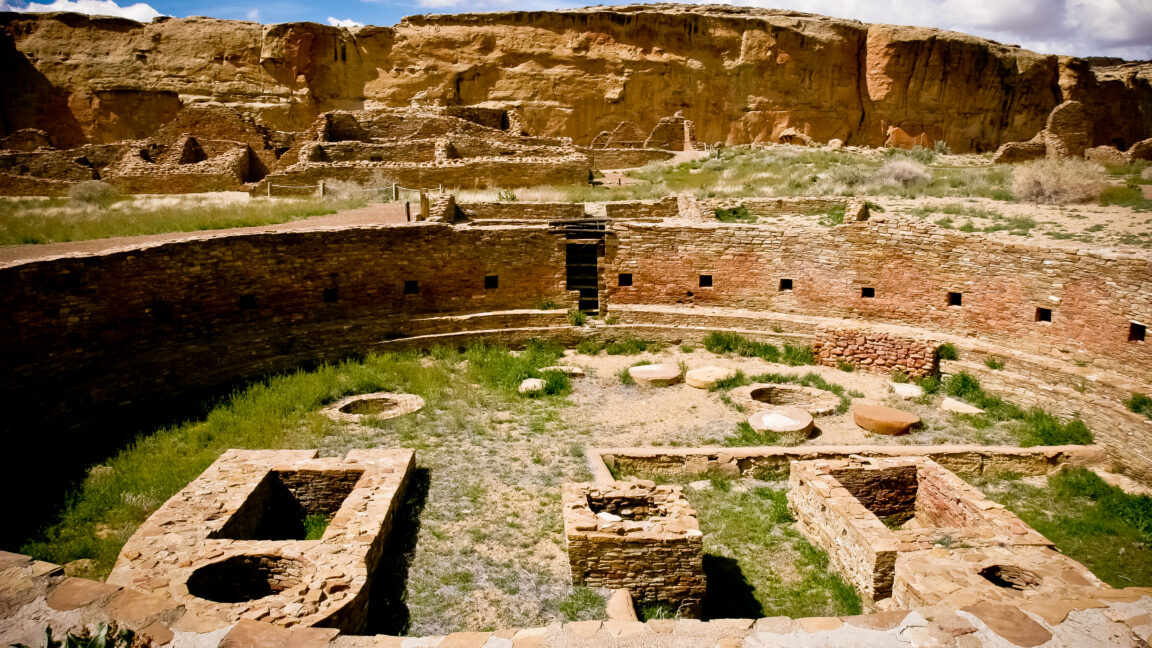
ARSTECHNICA.COM
DNA links modern pueblo dwellers to Chaco Canyon people
Deep connections
DNA links modern pueblo dwellers to Chaco Canyon people
People in Picuris Pueblo wanted to know how they got there, contacted researchers.
John Timmer
–
Apr 30, 2025 5:28 pm
|
5
A ceremonial structure in Chaco Canyon.
Credit:
P. Wei
A ceremonial structure in Chaco Canyon.
Credit:
P. Wei
Story text
Size
Small
Standard
Large
Width
*
Standard
Wide
Links
Standard
Orange
* Subscribers only
Learn more
A thousand years ago, the people living in Chaco Canyon were building massive structures of intricate masonry and locations as far away as Mexico. Within a century, however, the area would be largely abandoned, with little indication that the same culture was re-established elsewhere. If the people of Chaco Canyon migrated elsewhere, it's unclear where they ended up.
Around the same time that construction expanded in Chaco Canyon, far smaller pueblos began appearing in the northern Rio Grande Valley hundreds of kilometers away. These have remained occupied to the present day in New Mexico; although their populations shrank dramatically after European contact, their relationship to the Chaco culture has remained ambiguous. Until now, that is. People from one of these communities, Picuris Pueblo, worked with ancient DNA specialists to show that they are the closest relatives of the Chaco people yet discovered, confirming aspects of the pueblo's oral traditions.
A pueblo-driven study
The list of authors of the new paper describing this genetic connection includes members of the Pueblo government, including its present governor. That's because the study was initiated by the members of the Pueblo, who worked with archeologists to get in contact with DNA specialists at the Center for GeoGenetics at the University of Copenhagen. In a press conference, members of the Pueblo said they'd been aware of the power of DNA studies via their use in criminal cases and ancestry services. The leaders of Picuris Pueblo felt that it could help them understand their origin and the nature of some of their oral history, which linked them to the wider Pueblo-building peoples.
After two years of discussions, the collaboration settled on a plan of research, and the ancient DNA specialists were given access to both ancient skeletons at Picuris Pueblo, as well as samples from present-day residents. These were used to generate complete genome sequences.
The first clear result is that there is a strong continuity in the population living at Picuris. The ancient skeletons range from 500 to 700 years old, and thus date back to roughly the time of European contact, with some predating it. They also share strong genetic connections to the people of Chaco Canyon, where DNA has also been obtained from remains. "No other sampled population, ancient or present-day, is more closely related to Ancestral Puebloans from Pueblo Bonito [in Chaco Canyon] than the Picuris individuals are," the paper concludes.
There are several things that this does not mean. There is no way to tell from this data whether former residents of Chaco contributed to the population that was present at Picuris 700 years ago. It also does not preclude the possibility that residents of other Pueblos in the northern Rio Grande Valley are equally or even more related. Genomic data from these populations is very sparse, so it's hard to say anything much about how residents of Picuris Pueblo relate to other groups in the region.
Coming to the Americas
In addition, the data placed the Picuris residents in the context of the peopling of North America. There's a major split between indigenous populations in the northern parts of North America (Athabaskan populations), and everyone south of that, including all of Central and South America, as well as the ancient Clovis, New Mexico, population. The boundary between this split is a bit fuzzy; at least some of the Athabaskans migrated to the US Southwest.
The Picuris people are clearly part of the southern group, but also seem to have ancestors from a separate branch of that group who were likely contemporaries of the Clovis population. We have no information whatsoever about any population that corresponds to this genetic lineage.
Although the study didn't provide a clear answer to every question biologists might have, it appeared to leave the residents of Picuris Pueblo satisfied, as it helped clarify their oral tradition, which is a bit fragmentary because of the sudden drop in population that followed European contact. And, perhaps as importantly, the Picuris leadership was emphatic that they lead the process, and the work was designed to get them the answers they were most interested in.
It's a big contrast to a lot of the past scientific inquiry into the history of indigenous populations, which often involved cavalier seizures of remains and a general dismissal of oral histories. That's starting to change, as researchers are starting to work with native populations to help define the questions that interest them most, and science can address. Hopefully, as more groups see successful collaborations like this one, we'll get a clearer picture of our complicated history.
Nature, 2025. DOI: 10.1038/s41586-025-08791-9 (About DOIs).
John Timmer
Senior Science Editor
John Timmer
Senior Science Editor
John is Ars Technica's science editor. He has a Bachelor of Arts in Biochemistry from Columbia University, and a Ph.D. in Molecular and Cell Biology from the University of California, Berkeley. When physically separated from his keyboard, he tends to seek out a bicycle, or a scenic location for communing with his hiking boots.
5 Comments
0 Commentaires
0 Parts
60 Vue


